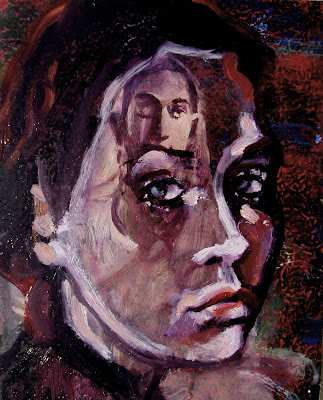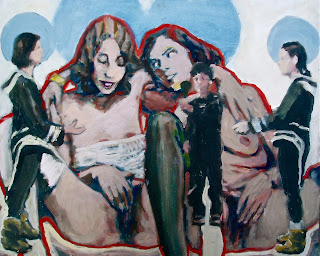 |
San women singing
oil on on acrylic on found canvas, 30 x 40 inches, 2016 |
The depiction of a human being, the only one found at Lascaux, is widely interpreted as an image of a shaman. A nineteenth century photograph of a (Californian) shaman clearly shows a similarity with the figure depicted in the caves of Lascaux some 17.000 years earlier. Literature accepting the shamanic interpretation focuses on the depiction of the man in an ecstatic trance state as opposed to the earlier interpretation as a man in the throes of death. A shaman symbolically dies before entering the spirit realm. Georges Bataille uses the term little death (la petite mort) in discussing the state the human at Lascaux. David Lewis-Williams and Jean Clottes, against the archaeological taboo of making inferences by ethnographical analogy, first forwarded their theories linking cave paintings with shamanic ritual in 1996.31 Lewis-Williams had studied the San since the early nineteen-eighties. Research by Lewis-Williams into trance ceremonies performed by the San people in Namibia has shown that the shaman in a state of trance figuratively dies. He collapses and his soul leaves the body and travels to the spirit world. Before the San were studied in Namibia they had lived near Drakensberg in South Africa until the late nineteenth century, when they were displaced by the South African Government. The San had a long tradition of cave and rock painting while at Drakensberg but in their new home in the Kalahari Desert this tradition ended. There are no caves in the desert and the San stopped painting but still live according to their traditions. South African rock paintings by the San peoples bear striking similarities with cave paintings found in Southern Europe. German philologist Wilhelm Bleek, together with Lucy Lloyd, studied the San people at a time when they were still active at Drakensberg. They left behind an enormous archive of transcripts of interviews, giving a detailed account of San customs, beliefs, and language. The assumed analogy of the San people and the Paleolithic cave painters provide us with valuable information on the lives and works of the latter, but shamanic interpretations of cave art are still disputed. Through an analogy with shamanic cultures, that have been studied in Siberia and North America in the early twentieth century, and with the San people of South Africa, researchers sketched an outline of the first known artists that existed in southern France and Northern Spain about 40,000 years ago. Lewis-Williams and Clottes speculate that the shamans of southern France and northern Spain were the first professional artists. Individuals who have been designated to perform the function of artists within a community can be distinguished by their psychological traits, often at an early age. The individuals were chosen to be artists through their character of otherness. They could be men or women.
The above is a section from my forthcoming textbook You are an Artist! For the very reason the text is included in an art textbook, the San are one of the most interesting peoples to look at, and listen too, in the context of musicology. Deemed unscientific to form any conclusion on prehistoric arts by inference of the ethnography of recent cultures, listening to San ceremonies one can nonetheless sense what music like was during Paleolithic times. Personally I don't see a reason why the traditions of the San aren't many thousands of years old. The tune in the top 100 is from a giraffe hunting ceremony found on Youtube. The ceremony is performed by five female singers surrounded by dancing males and children. All five singers are depicted within the smaller circles of the painting above, one of the larger ones I've made in a while. The painting is superimposed on a found canvas that was originally used to paint a family portrait on. Footsteps, hand prints, and the ages of the family members were painted and printed onto the canvas that also had a bunch of circles painted on it. The circles I used unaltered to paint the portraits of female San singers, the composition thereby was predetermined.





































